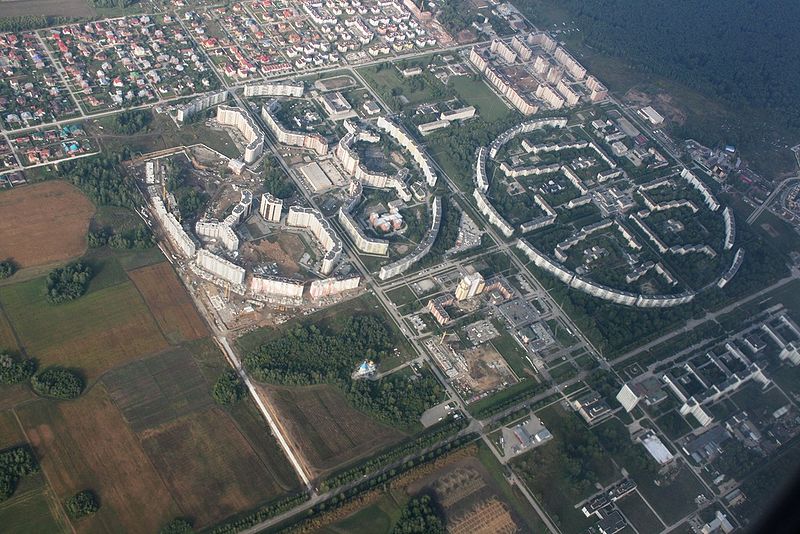Brasilia Syndrome
Contents |
[edit] Introduction
Brasilia Syndrome (also known as Helicopter Urbanism or Birdshit Architecture) is a term introduced by Jan Gehl to describe certain types of urban planning that became popular in the 1950s and is still in use. These developments look impressive from a bird’s eye view but fail to function effectively - and may be unwelcoming - for those people who experience the cities at ground level. Gehl feels that Brasilia Syndrome most often occurs when the larger, more remote scale is emphasised while the smaller, human scale is disregarded.
Gehl places some of the blame on two contemporary trends - modernist architecture and the car culture mentality. Gehl suggests that plans are created by those who are looking from high above and are dropped to the ground with no regard for those below. This vantage point - from a helicopter, airplane or drone - may be impressive, but at ground level, layouts fail to factor in distances and experiences for those who must live, work, walk and cycle through them.
[edit] Observing people in cities
Gehl is a Danish architect and urban planner who has written about Brasilia Syndrome based on observations he made while analysing human behaviour in cities. He noted that people preferred to collect around the edges of cities rather than gather in the open.
In a series of studies, he gathered data to help him confirm or deny his theory. Thee statistics reinforced his observations and found that cycle-friendly, human-scaled cities (such as Copenhagen) provide a completely different experience for their inhabitants. By contrast, Brasilia Syndrome cities, such as Dubai, fail from the perspective of those who experience them as pedestrians or cyclists.
These geometric, car-centric plans are made up of buildings that lack detail and are typically in straight, monotonous lines. This may be optimal for motorised vehicles, but it is unnatural for pedestrians or cyclists (particularly when compared to ancient cities like Rome, where there are practically no straight lines).
Poor public space is often discussed in terms of the negative effects of the modern idiom, in which coherent urban fabric is replaced by buildings as objects, which fail to define space and result in a reduction in quality in what Gehl calls ‘life between buildings’. Instead, Gehl feels that cities should be designed where people - not cars or buildings - serve as the starting point for sustainable living spaces.
[edit] Case study: Brasilia
The capital of Brazil is namesake behind Helicopter Urbanism. It was planned in the mid 1950s by Lúcio Costa, Oscar Niemeyer and Joaquim Cardozo and was specifically designed as the country’s new capital.
Before the city was established, the area resembled a desert. It was conceived as a practical utopia with Oscar Niemeyer designing hundreds of buildings. There are several designated sectors - a hotel sector, a banking sector, an embassy sector and so on - with specific purposes. The architecture is predominantly modernist, and the city was named as a UNESCO World Heritage Site in recognition of its architecture and urban planning.
From the air, Brasilia is impressively designed in the shape of an eagle. The sector of white government buildings is situated at the eagle’s head, and the residential housing blocks are arranged in neighbourhoods around green areas and placed in the eagle's wings.
Satellite image of Brasilia.
While Brasilia has received accolades for its urban planning, it is not generally thought of as a successful arrangement by its residents. The scale is considered too spread out to be practical. Pedestrians and cyclists reject walkways that are too long, formal and monotonous. Instead, they opt to walk and cycle across the green areas, creating their own organic, human-centric trails.
[edit] Related articles on Designing Buildings Wiki
Featured articles and news
The UK’s largest air pollution campaign.
Future Homes Standard, now includes solar, but what else?
Will the new standard, due to in the Autumn, go far enough in terms of performance ?
BSRIA Briefing: Cleaner Air, Better tomorrow
A look back at issues relating to inside and outside air quality, discussed during the BSRIA briefing in 2023.
Restoring Abbotsford's hothouse
Bringing the writer Walter Scott's garden to life.
Reflections on the spending review with CIAT.
Retired firefighter cycles world to raise Grenfell funds
Leaving on 14 June 2025 Stephen will raise money for youth and schools through the Grenfell Foundation.
Key points for construction at a glance with industry reactions.
Functionality, visibility and sustainability
The simpler approach to specification.
Architects, architecture, buildings, and inspiration in film
The close ties between makers and the movies, with our long list of suggested viewing.
SELECT three-point plan for action issued to MSPs
Call for Scottish regulation, green skills and recognition of electrotechnical industry as part of a manifesto for Scottish Parliamentary elections.
UCEM becomes the University of the Built Environment
Major milestone in its 106-year history, follows recent merger with London School of Architecture (LSE).
Professional practical experience for Architects in training
The long process to transform the nature of education and professional practical experience in the Architecture profession following recent reports.
A people-first approach to retrofit
Moving away from the destructive paradigm of fabric-first.
International Electrician Day, 10 June 2025
Celebrating the role of electrical engineers from André-Marie Amperè, today and for the future.
New guide for clients launched at Houses of Parliament
'There has never been a more important time for clients to step up and ...ask the right questions'
The impact of recycled slate tiles
Innovation across the decades.
EPC changes for existing buildings
Changes and their context as the new RdSAP methodology comes into use from 15 June.


























